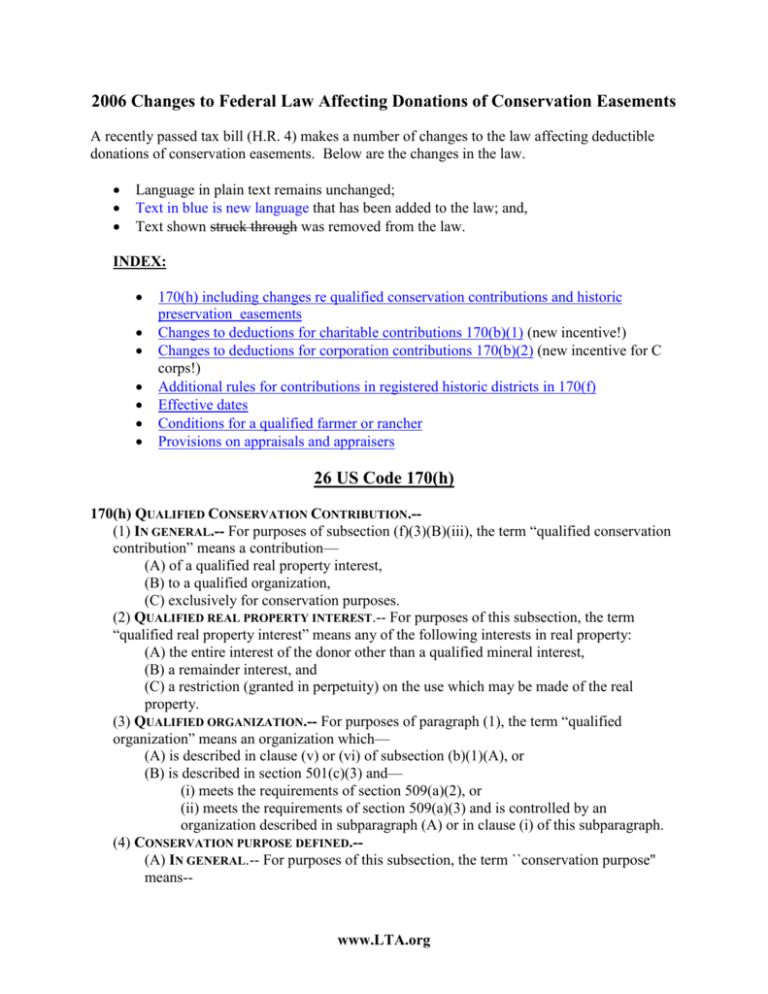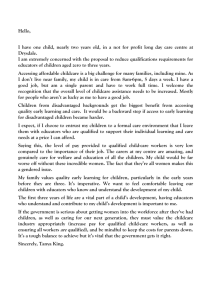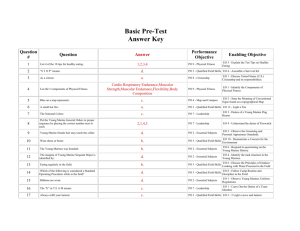Change to IRC 170(b)(1)
advertisement

2006 Changes to Federal Law Affecting Donations of Conservation Easements A recently passed tax bill (H.R. 4) makes a number of changes to the law affecting deductible donations of conservation easements. Below are the changes in the law. Language in plain text remains unchanged; Text in blue is new language that has been added to the law; and, Text shown struck through was removed from the law. INDEX: 170(h) including changes re qualified conservation contributions and historic preservation easements Changes to deductions for charitable contributions 170(b)(1) (new incentive!) Changes to deductions for corporation contributions 170(b)(2) (new incentive for C corps!) Additional rules for contributions in registered historic districts in 170(f) Effective dates Conditions for a qualified farmer or rancher Provisions on appraisals and appraisers 26 US Code 170(h) 170(h) QUALIFIED CONSERVATION CONTRIBUTION.-(1) IN GENERAL.-- For purposes of subsection (f)(3)(B)(iii), the term “qualified conservation contribution” means a contribution— (A) of a qualified real property interest, (B) to a qualified organization, (C) exclusively for conservation purposes. (2) QUALIFIED REAL PROPERTY INTEREST.-- For purposes of this subsection, the term “qualified real property interest” means any of the following interests in real property: (A) the entire interest of the donor other than a qualified mineral interest, (B) a remainder interest, and (C) a restriction (granted in perpetuity) on the use which may be made of the real property. (3) QUALIFIED ORGANIZATION.-- For purposes of paragraph (1), the term “qualified organization” means an organization which— (A) is described in clause (v) or (vi) of subsection (b)(1)(A), or (B) is described in section 501(c)(3) and— (i) meets the requirements of section 509(a)(2), or (ii) meets the requirements of section 509(a)(3) and is controlled by an organization described in subparagraph (A) or in clause (i) of this subparagraph. (4) CONSERVATION PURPOSE DEFINED.-(A) IN GENERAL.-- For purposes of this subsection, the term ``conservation purpose'' means-- www.LTA.org (i) the preservation of land areas for outdoor recreation by, or the education of, the general public, (ii) the protection of a relatively natural habitat of fish, wildlife, or plants, or similar ecosystem, (iii) the preservation of open space (including farmland and forest land) where such preservation is-(I) for the scenic enjoyment of the general public, or (II) pursuant to a clearly delineated Federal, State, or local governmental conservation policy, and will yield a significant public benefit, or (iv) the preservation of an historically important land area or a certified historic structure. (B) SPECIAL RULES WITH RESPECT TO BUILDINGS IN REGISTERED HISTORIC DISTRICTS.-- In the case of any contribution of a qualified real property interest which is a restriction with respect to the exterior of a building described in subparagraph (C)(ii), such contribution shall not be considered to be exclusively for conservation purposes unless-(i) such interest-(I) includes a restriction which preserves the entire exterior of the building (including the front, sides, rear, and height of the building), and (II) prohibits any change in the exterior of the building which is inconsistent with the historical character of such exterior, (ii) the donor and donee enter into a written agreement certifying, under penalty of perjury, that the donee-(I) is a qualified organization (as defined in paragraph (3)) with a purpose of environmental protection, land conservation, open space preservation, or historic preservation, and (II) has the resources to manage and enforce the restriction and a commitment to do so, and (iii) in the case of any contribution made in a taxable year beginning after the date of the enactment of this subparagraph, the taxpayer includes with the taxpayer's return for the taxable year of the contribution-(I) a qualified appraisal (within the meaning of subsection (f)(11)(E)) of the qualified property interest, (II) photographs of the entire exterior of the building, and (III) a description of all restrictions on the development of the building. (B) (C) CERTIFIED HISTORIC STRUCTURE - For purposes of subparagraph (A)(iv), the term ``certified historic structure'' means any building, structure, or land area which-(i) any building, structure or land area which is listed in the National Register, or (ii) any building which is located in a registered historic district (as defined in section 47(c)(3)(B)) and is certified by the Secretary of the Interior to the Secretary as being of historic significance to the district. A building, structure, or land area satisfies the preceding sentence if it satisfies such sentence either at the time of the transfer or on the due date (including extensions) for filing the 2 transferor's return under this chapter for the taxable year in which the transfer is made. (5) EXCLUSIVELY FOR CONSERVATION PURPOSES.-- For purposes of this subsection— (A) CONSERVATION PURPOSE MUST BE PROTECTED.-- A contribution shall not be treated as exclusively for conservation purposes unless the conservation purpose is protected in perpetuity. (B) NO SURFACE MINING PERMITTED.-(i) IN GENERAL.-- Except as provided in clause (ii), in the case of a contribution of any interest where there is a retention of a qualified mineral interest, subparagraph (A) shall not be treated as met if at any time there may be extraction or removal of minerals by any surface mining method. (ii) SPECIAL RULE.-- With respect to any contribution of property in which the ownership of the surface estate and mineral interests has been and remains separated, subparagraph (A) shall be treated as met if the probability of surface mining occurring on such property is so remote as to be negligible. (6) Qualified mineral interest. For purposes of this subsection, the term “qualified mineral interest” means— (A) subsurface oil, gas, or other minerals, and (B) the right to access to such minerals. Change to IRC 170(b)(1) Section 170(b) limits the deductions for charitable contributions. Section 1206(a)(1) of HR 4297 inserts a brand new subparagraph 170(b)(1)(E) and redesignates the former subparagraphs (E) and (F) as (F) and (G). Below is the new subparagraph. (E) CONTRIBUTIONS OF QUALIFIED CONSERVATION CONTRIBUTIONS.-(i) IN GENERAL.-- Any qualified conservation contribution (as defined in subsection (h)(1)) shall be allowed to the extent the aggregate of such contributions does not exceed the excess of 50 percent of the taxpayer's contribution base over the amount of all other charitable contributions allowable under this paragraph. (ii) CARRYOVER.-- If the aggregate amount of contributions described in clause (i) exceeds the limitation of clause (i), such excess shall be treated (in a manner consistent with the rules of subsection (d)(1)) as a charitable contribution to which clause (i) applies in each of the 15 succeeding years in order of time. (iii) COORDINATION WITH OTHER SUBPARAGRAPHS.-- For purposes of applying this subsection and subsection (d)(1), contributions described in clause (i) shall not be treated as described in subparagraph (A), (B), (C), or (D) and such paragaphs shall apply without regard to such contributions. (iv) SPECIAL RULE FOR CONTRIBUTION OF PROPERTY USED IN AGRICULTURE OR LIVESTOCK PRODUCTION.-- 3 (I) IN GENERAL.-- If the individual is a qualified farmer or rancher for the taxable year in which the contribution is made, clause (i) shall be applied by substituting `100 percent' for `50 percent'. (II) EXCEPTION.—Subclause (I) shall not apply to any contribution of property made after the date of enactment of this paragraph which is used in agriculture or livestock production (or available for such production) unless such contribution is subject to a restriction that such property remain available for such production. This subparagraph shall be applied separately with respect to property to which subclause (I) does not apply by reason of the preceeding sentence prior to its application to property to which subclause (I) does apply. (v) DEFINITION.-- For purposes of clause (iv), the term `qualified farmer or rancher' means a taxpayer whose gross income from the trade or business of farming (within the meaning of section 2032A(e)(5)) is greater than 50 percent of the taxpayer's gross income for the taxable year. Change to 170(b)(2) Subsection 170(b)(2) limits the deductions for corporations. Section 1206(a)(2) of HR 4 rewrites IRC 170(b)(2) to read as below. (2) CORPORATIONS- In the case of a corporation-(A) IN GENERAL.-- The total deductions under subsection (a) for any taxable year (other than for contributions to which subparagraph (B) applies) shall not exceed 10 percent of the taxpayer's taxable income. (B) QUALIFIED CONSERVATION CONTRIBUTIONS BY CERTAIN CORPORATE FARMERS AND RANCHERS.-(i) IN GENERAL.-- Any qualified conservation contribution (as defined in subsection (h)(1)) -(I) which is made by a corporation which, for the taxable year during which the contribution is made, is a qualified farmer or rancher (as defined in paragraph (1)(E)(v)) and the stock of which is not readily tradable on an established securities market at any time during such year, and (II) which, in the case of contributions made after the date of enactment of this subparagraph, is a contribution of property which is used in agriculture or livestock production (or available for such production) and which is subject to a restriction that such property remain available for such production, shall be allowed to the extent the aggregate of such contributions does not exceed the excess of the taxpayer's taxable income over the amount of charitable contributions allowable under subparagraph (A). (ii) CARRYOVER.-- If the aggregate amount of contributions described in clause (i) exceeds the limitation of clause (i), such excess shall be treated (in a manner 4 consistent with the rules of subsection (d)(2)) as a charitable contribution to which clause (i) applies in each of the 15 succeeding years in order of time. (B)(C) TAXABLE INCOME.-- For purposes of this paragraph, taxable income shall be computed without regard to-(i) this section, (ii) part VIII (except section 248), (iii) any net operating loss carrryback to the taxable year under section 172, (iv) section 199, and (v) any capital loss carryback to the taxable year under section 1212(a)(1). Other Changes to 170(b) Section 1206 (c) of HR 4 provides that these changes apply to contributions made in taxable years beginning after December 31, 2005. Changes to 170(f) (13) CONTRIBUTIONS OF CERTAIN INTERESTS IN BUILDINGS LOCATED IN REGISTERED HISTORIC DISTRICTS.-(A) IN GENERAL.-- No deduction shall be allowed with respect to any contribution described in subparagraph (B) unless the taxpayer includes with the return for the taxable year of the contribution a $500 filing fee. (B) CONTRIBUTION DESCRIBED.-- A contribution is described in this subparagraph if such contribution is a qualified conservation contribution (as defined in subsection (h)) which is a restriction with respect to the exterior of a building described in subsection (h)(4)(C)(ii) and for which a deduction is claimed in excess of $10,000. (C) DEDICATION OF FEE.-- Any fee collected under this paragraph shall be used for the enforcement of the provisions of subsection (h). (14) REDUCTION FOR AMOUNTS ATTRIBUTABLE TO REHABILITATION CREDIT.—In the case of any qualified conservation contribution (as defined in subsection (h)), the amount of the deduction allowed under this section shall be reduced by an amount which bears the same ratio to the fair market value of the contribution as— (A) the sum of the credits allowed to the taxpayer under section 47 for the 5 preceeding taxable years with respect to any building which is part of such contribution, bears to (B) the fair market value of the building on the date of the contribution. Effective dates The changes made to 170(b) are effective for donations made in tax years January1, 2006 through December 31, 2007. 5 Paragraph 170(f)(13) is made effective 180 days after the date of enactment. Paragraph 170(f)(14) is made effective as of the date of enactment. The new language of 170(h)(4)(B) is effective for easements donated after July 25, 2006. The changes made to 170(h)(4)(C) are effective as of the date of enactment. Qualifying Farmer or Rancher Definition Section 170(b)(1)(E)(4) defines a “qualified farmer or rancher” in terms of IRC 2032A(e)(5). That paragraph is reproduced below. “(5) The term ''farming purposes'' means (A) cultivating the soil or raising or harvesting any agricultural or horticultural commodity (including the raising, shearing, feeding, caring for, training, and management of animals) on a farm; (B) handling, drying, packing, grading, or storing on a farm any agricultural or horticultural commodity in its unmanufactured state, but only if the owner, tenant, or operator of the farm regularly produces more than one-half of the commodity so treated; and (C)(i) the planting, cultivating, caring for, or cutting of trees, or (ii) the preparation (other than milling) of trees for market.” Provisions on Appraisers and Appraisals SEC. 1219. PROVISIONS RELATING TO SUBSTANTIAL AND GROSS OVERSTATEMENTS OF VALUATIONS.-(a) MODIFICATION OF THRESHOLDS FOR SUBSTANTIAL AND GROSS VALUATION MISSTATEMENTS.-(1) SUBSTANTIAL VALUATION MISSTATEMENT.-(A) INCOME TAXES.-- Subparagraph (A) of section 6662(e)(1) (relating to substantial valuation misstatement under chapter 1) is amended by striking `200 percent' and inserting `150 percent'. (B) ESTATE AND GIFT TAXES.-- Paragraph (1) of section 6662(g) is amended by striking `50 percent' and inserting `65 percent'. (2) GROSS VALUATION MISSTATEMENT(A) INCOME TAXES- Clauses (i) and (ii) of section 6662(h)(2)(A) (relating to increase in penalty in case of gross valuation misstatements) are amended to read as follows: `(i) in paragraph (1)(A), `200 percent' for `150 percent', `(ii) in paragraph (1)(B)(i)-`(I) `400 percent' for `200 percent', and `(II) `25 percent' for `50 percent', and'. (B) ESTATE AND GIFT TAXES- Subparagraph (C) of section 6662(h)(2) is amended by striking `25 percent' for `50 percent' and inserting `40 percent' for `65 percent'. (b)……(this language not included here) (c) QUALIFIED APPRAISERS AND APPRAISALS.-6 (1) IN GENERAL- Subparagraph (E) of section 170(f)(11) is amended to read as follows: “(E) QUALIFIED APPRAISAL AND APPRAISER- For purposes of this paragraph-(i) QUALIFIED APPRAISAL- The term `qualified appraisal' means, with respect to any property, an appraisal of such property which-(I) is treated for purposes of this paragraph as a qualified appraisal under regulations or other guidance prescribed by the Secretary, and (II) is conducted by a qualified appraiser in accordance with generally accepted appraisal standards and any regulations or other guidance prescribed under subclause (I). (ii) QUALIFIED APPRAISER- Except as provided in clause (iii), the term `qualified appraiser' means an individual who-(I) has earned an appraisal designation from a recognized professional appraiser organization or has otherwise met minimum education and experience requirements set forth in regulations prescribed by the Secretary, (II) regularly performs appraisals for which the individual receives compensation, and (III) meets such other requirements as may be prescribed by the Secretary in regulations or other guidance. (iii) SPECIFIC APPRAISALS- An individual shall not be treated as a qualified appraiser with respect to any specific appraisal unless-(I) the individual demonstrates verifiable education and experience in valuing the type of property subject to the appraisal, and (II) the individual has not been prohibited from practicing before the Internal Revenue Service by the Secretary under section 330(c) of title 31, United States Code, at any time during the 3-year period ending on the date of the appraisal.” (2) APPRAISER PROVISIONS- Except as provided in paragraph (3), the amendments made by subsections (b), (c), and (d) shall apply to appraisals prepared with respect to returns or submissions filed after the date of the enactment of this Act. (3) SPECIAL RULE FOR CERTAIN EASEMENTS- In the case of a contribution of a qualified real property interest which is a restriction with respect to the exterior of a building described in section 170(h)(4)(C)(ii) of the Internal Revenue Code of 1986, and an appraisal with respect to the contribution, the amendments made by subsections (a) and (b) shall apply to returns filed after July 25, 2006. 7





